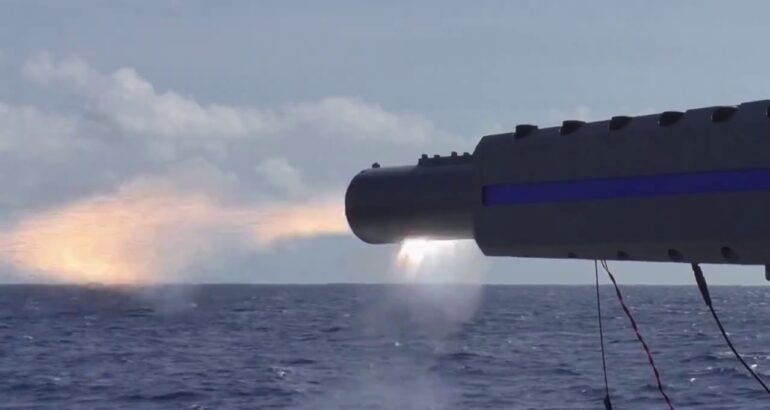I don’t know about you, but I need a break from the Gaza conflict of 2023. I’ll return to it tomorrow, with a maritime focus, but for today … well … I’m a simple man with simple needs … and I can’t help but acknowledge my weaknesses …
Yes, I know the proper cynical approach to the promise of railguns is best summarized as the Brazil of weapons systems;
Railguns are the weapon of the future, and always will be.
The USA tried and failed. The PRC looked like they were going somewhere, but alas, it appears it didn’t.
What other nation has the resources or technology to perhaps make a run of it?
Remember this note from April?
It’s a “futuristic” technology that has been in development off and on for more than 100 years.
Electromagnetic railguns were first conceived in France during World War I. Since then, everyone from the Nazis in Germany, to China, Russia, India and the U.S. Army, have attempted to field the potentially game-changing weapon of war.
The U.S Navy, after spending some 15 years and $500 million developing a railgun for destroyers, gave up on the idea in 2021.
But the railgun concept is not dead.
Japan’s Ministry of Defense is looking to partner with the United States on a railgun program that could be used to counter hypersonic weapons, a senior Japanese official told National Defense recently.
A railgun uses electricity flowing between two parallel conductors to shoot a non-explosive projectile at high speeds over long distances. The velocity results in such a powerful impact, explosives are not needed to cause considerable damage.
Despite the concept being around more than a century, no militaries have successfully fielded a railgun.
Shigenori Mishima, vice commissioner and chief technology officer at the Japanese Ministry of Defense’s Acquisition, Technology and Logistics Agency, listed a railgun as one of the military’s top research and development priorities at the DSEI Japan conference recently.
When pressed for details, he said the agency has been doing basic research on the technology for the past 10 years, but it could use help bringing the technology over the finish line.
Yes, I know, I know, I know.
Did Japan get the USA to join in? Knowing how slow these things in DC can be, I’m not sure, however last week …
The Japanese Ministry of Defense’s Acquisition, Technology & Logistics Agency (ATLA) announced that it has accomplished a ship-board firing test of a railgun for the first time in the world. The test was conducted with the cooperation of the Japan Maritime Self-Defense Force (JMSDF).
Kosuke Takahashi 19 Oct 2023
ATLA released video footage on social media X (formerly Twitter), on October 17. The footage shows a developmental electromagnetic (EM) railgun firing an unspecified number of rounds into the ocean from a vessel.
“To protect vessels against air-threats and surface-threats with high-speed bullets, ATLA strongly promotes early deployment of railgun technology,” ATLA said on X.
You can see the admittedly underwhelming video on X here.
Here’s the thing, at the start naval surface to air missiles were not that impressive and had a lot of limitation … but steady, calm, and clear-eyed iterative development brought us to the place we are today where the 27-yr old USS Carney (DDG 64) took out what we believe was about 4 land attack cruise missiles and ~15 attack drones over a couple of watches.
If the USN, like some … let’s see … how did I put it 15-months ago;
…our leadership lacks the ability to have a sustained baseline strategy that lasts longer than a FITREP cycle and instead invents new buzzwords to chase around like a catnip addled kitty after a laser pointer.
…and decided to abandon rail guns due to a technological or intellectual dead end, could the Japanese pick up the ball, take a different approach, and succeed?
“The decision to pause the EMRG program is consistent with department-wide reform initiatives to free up resources in support of other Navy priorities [which] include improving offensive and defensive capabilities such as directed energy, hypersonic missiles and electronic warfare systems,” the Navy told Military.com upon the program’s cancelation in July 2021.
However, hypersonic defense is what Japan sees as the gun’s primary application, Mishima said. It could also be land-based for island defense and shore-to-ship applications, he added. Hypersonic missiles and aircraft are defined as highly maneuverable and can reach Mach 5 or higher, which is a speed that railguns could be expected to achieve.
“If we can demonstrate the railgun, the United States might change its mind on the technology,” he said. It would be a win-win for everybody, he said.
New technology is hard, and to really make breakthroughs, you have to have the right leadership, scientists, engineers - and money - at the right time to make it happen. Remember, the USA was not the only power that was trying to make nuclear weapons work in WWII - we just were successful.
Time will tell, but I can’t wait to see where this is in five years. Maybe groundbreaking, maybe another failure - but that is where progress is made, on a pile of failures.
Oh, did you catch this bit?
Starting in fiscal year 2022, we have been conducting research aimed at establishing the overall technology necessary for early practical realization of railguns, including rapid fire performance and stability during flight,
What? Railguns in aircraft.
Well, if we could just mount this puppy on a ShinMaywa US-2 - well, there we’d have something!







I saw this article earlier in the week & was quite pleased the Japanese have started their own program.
If history is any predictor, the Japanese will take our research , succeed in making a practical unit and sell it back to us smaller & cheeper than we could do..
I'd love to see them partner on a common hull cruiser also.
Railguns on airships in 3, 2, 1 …